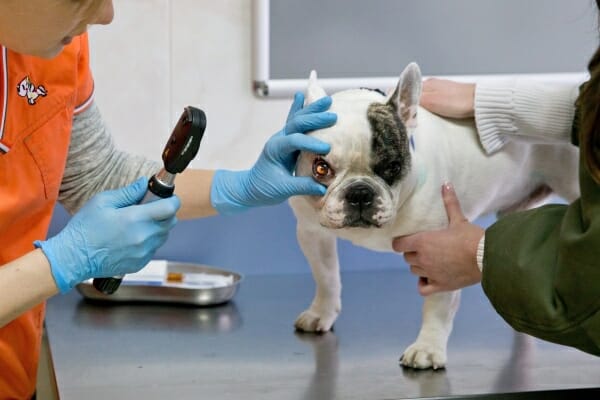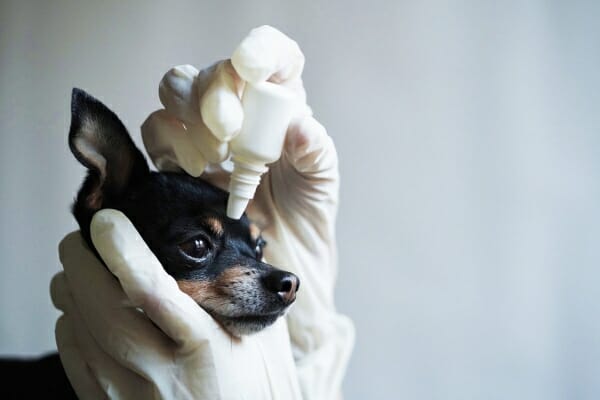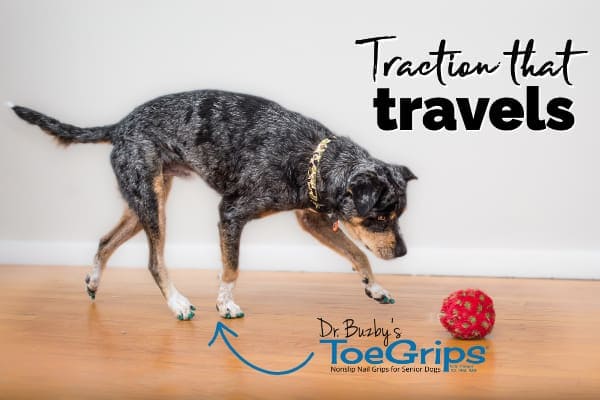Nuclear sclerosis in dogs can look a bit concerning until you know what is going on. Thankfully, this age-related discoloration of the lens of the eye doesn’t significantly affect your dog’s ability to see. Integrative veterinarian Dr. Julie Buzby explains this condition, and also compares it to cataracts in dogs—the eye condition dog parents most often confuse with nuclear sclerosis.

Picture a set of reading glasses perching on your senior dog’s muzzle. Pretty adorable, right?
Thankfully, dogs don’t need to use their close-up vision for reading, so they don’t need reading glasses like some humans. But dogs do undergo age-related changes in their eyes, the most common of which is called nuclear sclerosis. Also known as lenticular sclerosis, this condition causes discoloration of the center of the eye. To understand the causes, symptoms, and treatment, let’s first look at the anatomy of the eye.
The anatomy of the eye
As light enters the eye, it passes through the clear portion of the front of the eye, known as the cornea. The light then passes through the pupil. The pupil is the opening in the iris (i.e. colored portion of the eye). It can dilate or constrict to regulate how much light gets through.
Next, the light travels to the lens. This part of the eye is responsible for focusing the beam of light. To do this, the hard, disc-like lens changes shape in a process called accommodation.
The light then travels to the retina, where photoreceptors transform it into a nerve signal. This signal travels down the optic nerve to the brain where it is perceived as an image.
What is nuclear sclerosis in dogs?
Nuclear sclerosis describes age-related hardening of the lens of a dog’s eye. As a result of these changes, a small, round, pearly grey-colored opacity forms in the center of the lens. You may also notice a blue or grey haziness when looking into your dog’s eyes. Sometimes, this is easier to observe when looking at an affected eye from the side.

What causes nuclear sclerosis in dogs?
The eye’s lens is made up of layers of fibers that are constantly replenishing. As new lens fibers develop, the older fibers in the center (i.e. nucleus) of the lens can become compressed. This makes the nucleus more dense.
The name “nuclear sclerosis” describes this process well. Sclerosis refers to abnormal hardening of a tissue, which in this case is the nucleus of the lens. As the lens becomes more dense, it loses some of its clarity, and we can see some cloudiness when looking at affected eye(s).
Which dogs are most commonly affected?
Nuclear sclerosis generally occurs in middle aged or older dogs—typically those over seven years of age. It doesn’t seem to be more common in any particular breeds. However, increased exposure to UV radiation (sunlight) may make nuclear sclerosis occur more rapidly.
How is nuclear sclerosis in dogs diagnosed?
Nuclear sclerosis can be diagnosed with a simple eye exam as part of your dog’s routine physical exam. When the veterinarian examines your dog’s eyes, he or she will use a light to visualize the lens and see if the light appears to be passing through the lens and to the back of the eye. This can help distinguish between nuclear sclerosis and cataracts, a different kind of opacity of the lens.

If the lens has a grey or milky color in the center and is clear around the edges with no areas of complete opacity, this fits with nuclear sclerosis. Additionally, the vet will look for a yellow-green glow created by light reflecting off a structure in the back of the dog’s eye called the tapetum.
The tapetum is responsible for the green glow of an animal’s eyes when light hits them in the dark. If the vet sees a tapetal reflection, he or she knows light is getting through the lens and to the back of the eye.
Does nuclear sclerosis cause blindness in dogs?
Even though there is an observable change to the lens, nuclear sclerosis does not significantly affect vision. Most dogs are able to see just fine. Occasionally, some dog parents describe seeing signs of far-sightedness, almost as if their dog needs reading glasses. Affected dogs may also struggle with depth perception. This may make it harder for them to navigate stairs or catch a treat flying through the air.
What is the treatment for nuclear sclerosis in dogs?
Dogs with nuclear sclerosis do not require any treatment. There are no specific medications or supplements that will reverse the changes you are seeing. It is a normal part of the aging process. The good news is that nuclear sclerosis in dogs does not lead to any other eye diseases or significantly affect your pet’s vision.

Now that we have discussed this condition, let’s briefly contrast nuclear sclerosis with cataracts in dogs. These two eye conditions can be hard to distinguish at a glance. When I diagnose a dog with nuclear sclerosis, my clients are often understandably relieved. Many of them saw the hazy lens and understandably assumed that their dog had a cataract.
Nuclear sclerosis vs cataracts in dogs
Both of these conditions affect the lens. But there are some factors that help differentiate between nuclear sclerosis and cataracts. A few of the key differences are summarized in the table below.
| Nuclear Sclerosis in Dogs | Cataracts in Dogs | |
| Age at diagnosis | Middle-aged to older | Often older, but can happen at any age |
| Color of opacity | Grey | White |
| Placement within the lens | Center only | Often starts in center, may progress to entire lens |
| Vision changes | Possible mild far-sightedness or depth perception changes | Partial-to-complete vision loss |
| Normal with aging | Yes | No |
Cataracts are caused by degeneration of the lens, and can significantly affect a dog’s vision. Some dogs with cataracts will become blind because light can’t get through the opaque lens to the retina.
Unlike nuclear sclerosis, cataracts can also cause other eye health issues such as uveitis in dogs (i.e. inflammation of the iris and other structures) and glaucoma in dogs (i.e. increased pressure in the eye).
What causes cataracts in dogs?
Cataracts have a variety of causes including:
- Genetics
- Endocrine disease like diabetes mellitus
- Toxins
- Nutritional deficiencies
- Trauma to the eye

How are cataracts treated?
Dogs who are mostly or completely blind due to cataracts but have a normally functioning retina may benefit greatly from cataract surgery. A veterinarian who has been board certified by the American College of Veterinary Ophthalmology will perform the procedure while your dog is under general anesthesia.
During cataract surgery, the veterinary ophthalmologist will break up and then remove the diseased lens in a process known as phacoemulsification. Then he or she will implant an artificial lens to restore your dog’s vision.
Unfortunately, there are no other effective treatment options for cataracts. The good news, though, is that cataract surgery can greatly improve a dog’s quality of life. Dog parents often report that their dog is joyfully running around like a puppy again after the surgery.
Understandably, dog parents may wonder, “Is my dog too old for anesthesia?” or “Is my dog too old for surgery?” Thus, it is always a good idea to discuss the pros and cons of surgery with your veterinarian and veterinary ophthalmologist.
For a variety of reasons, cataract surgery may not be possible for every dog. The good news is, many blind dogs also live happy, fulfilled lives.

One of the ways you can help your visually impaired pup is to use our signature product, Dr. Buzby’s ToeGrips® dog nail grips. The extra traction provided by ToeGrips helps dogs feel more confident and secure in their footing, even if they can’t see.

Living with nuclear sclerosis
If you suspect something might be going on with your dog’s eyes, make an appointment with your veterinarian. Early detection of eye problems generally gives the best outcomes. If it turns out your dog has nuclear sclerosis—great! This is good news because it is a normal aging change and unlikely to have any major effects on your dog’s vision.

Does your dog have nuclear sclerosis?
Please comment below. We can all learn from each other.


My GSD has Nuclear sclerosis in both eyes and I was told, this was caused by the poultry products I’ve been giving. I was told to stop giving her any items with poultry and this will help clear most of the Nuclear sclerosis in about 9 months.
I’m curious, what food items do other folks give their dogs that also have this?
Thanks.
Sm
Hi Stanley,
I have never heard of poultry products causing nuclear sclerosis. I did a fair amount of research and did not find any references to this in any of the articles or publications I came across. As far as I know, this condition is not affected by diet changes. If you decide to avoid the poultry products for your pup, I would be curious to know the results! Feel free to leave an update if you have a chance.